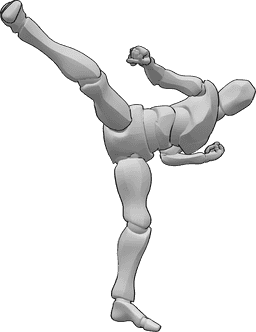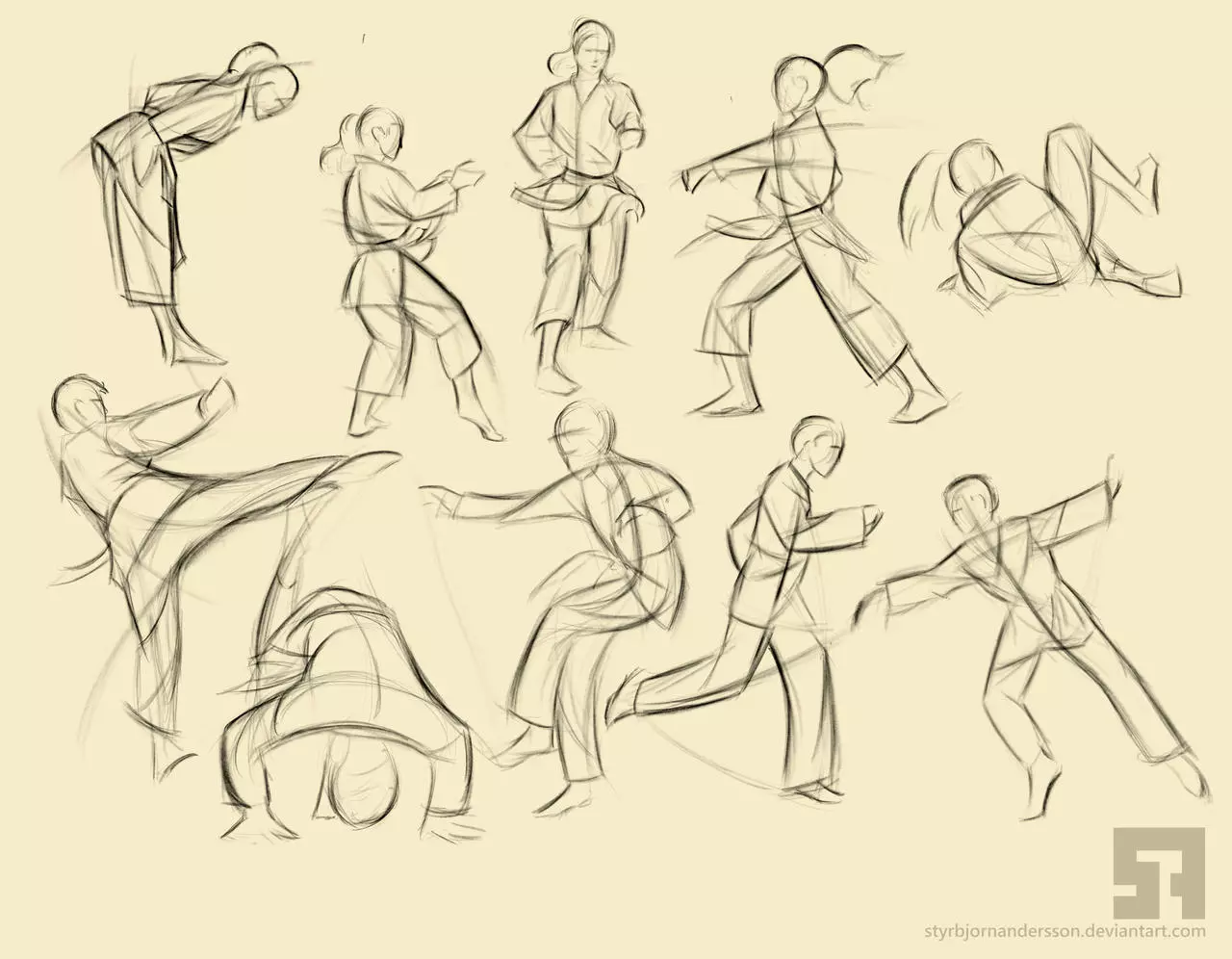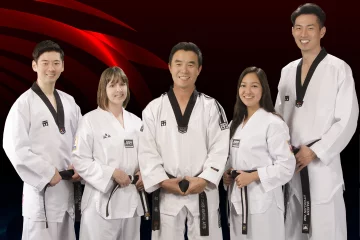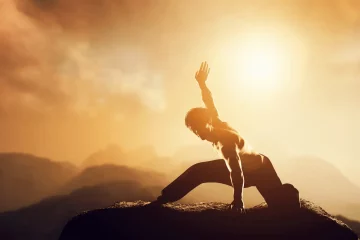As an Amazon Associate, I earn from qualifying purchases.
This article from the teamkathycarter website discusses about Martial Arts Poses.
Martial arts poses are specific stances used in various disciplines to execute techniques effectively and efficiently. These poses emphasize balance, power, and proper body alignment to achieve optimal performance in combat or practice.
Martial arts have a rich history rooted in ancient traditions and are practised globally by individuals seeking physical, mental, and spiritual development. Each pose serves a distinct purpose, such as defensive or offensive manoeuvres, improving flexibility, or building strength. In addition to their practical applications, martial arts poses require discipline, focus, and dedication to master.
Whether practising for self-defence, physical fitness, or competition, mastering martial arts poses is essential for any practitioner looking to advance in their chosen discipline. We will explore the significance of martial arts poses in different disciplines and their impact on overall performance and skill development.

Credit: www.gettyimages.com
The History Of Martial Arts- Martial Arts Poses
Discover the fascinating journey through time with The History of Martial Arts. Unveil ancient traditions, powerful techniques, and cultural significance.
Origins Of Martial Arts- Martial Arts Poses
Centuries ago, warriors developed Martial Arts for self-defence and combat strategies. Originating in Asia, different styles emerged.
Evolution Of Martial Arts Styles- Martial Arts Poses
Martial Arts evolved into diverse disciplines, such as Karate, Taekwondo, and kung fu. Each style has unique techniques and philosophies.
The Purpose Of Martial Arts Poses
Martial arts poses, also known as forms or katas, are a fundamental aspect of martial arts training. They consist of a series of prearranged movements and techniques performed in a specific sequence. While they may appear to be merely choreographed routines, these poses serve important purposes that go beyond their physical execution. Understanding the purpose of martial arts poses can shed light on their significance in training and the benefits they bring to practitioners.
Physical And Mental Discipline- Martial Arts Poses
The first purpose of martial arts poses is to develop physical and mental discipline. By repeatedly practising these poses, martial artists improve their balance, coordination, and overall physical fitness. The precise and controlled execution of each movement requires concentration, focus, and mental clarity. Through regular practice, martial artists cultivate discipline, patience, and self-control that extend beyond the training mat.
Self-defence Techniques- Martial Arts Poses
Martial arts pose also serve as a repository of self-defence techniques. Each pose is a collection of techniques that can be applied in real-life combat situations. By practising these poses, martial artists internalize the essential elements of effective self-defence, including strikes, kicks, blocks, and grappling techniques. Mastery of these techniques through regular repetition and refinement in poses empowers practitioners with the skills and confidence necessary to protect themselves and others in threatening situations.
Moreover, martial artists learn to react instinctively and adapt to different scenarios by connecting the dots between the poses and practical self-defence applications. Through constant practice and visualization, martial artists develop a heightened sense of awareness and the ability to anticipate and counteract potential threats.
Key Elements Of Martial Arts Poses
Martial arts poses are defined by the precise combination of stances, strikes and kicks, as well as blocks and parries. To achieve mastery in martial arts, practitioners must understand these key elements and execute them with precision.
Stances- Martial Arts Poses
In martial arts, stances form the foundation of a strong and balanced posture. They provide stability and power for executing techniques effectively.
Strikes And Kicks- Martial Arts Poses
Strikes and kicks are essential offensive components of martial arts poses. These techniques involve precise movements to target opponents with speed and force.
Blocks And Parries- Martial Arts Poses
Blocks and parries are defensive maneuvers that protect practitioners from incoming attacks. Proper execution of blocks and parries is crucial for self-defence and counterattacks.
Training For Martial Arts Poses
Mastering martial arts poses requires a dedicated training regimen that focuses on building strength, endurance, flexibility, and mobility. This comprehensive training approach ensures that fighters have the physical capabilities needed to perform complex poses and techniques with precision and power. In this article, we will explore two key aspects of training for martial arts poses: flexibility and mobility exercises, and strength and endurance training.
Flexibility And Mobility Exercises- Martial Arts Poses
Flexibility and mobility are essential for martial artists as they allow for a greater range of motion, prevent injuries, and improve overall performance. Here are some effective exercises to enhance flexibility and mobility:
- Dynamic stretching: Perform dynamic stretches like leg swings, arm circles, and torso twists to warm up your muscles and prepare them for movement.
- Static stretching: Hold stretches for 20-30 seconds to improve flexibility in various muscle groups such as hamstrings, hips, and shoulders. Examples include the butterfly stretch, standing quadriceps stretch, and chest stretches.
- Foam rolling: Use a foam roller to release tension in muscles and increase mobility. Roll over tight areas such as the calves, quads, and IT bands for optimal results.
- Yoga: Practicing yoga helps improve flexibility, balance, and body awareness. Poses like the downward-facing dog, pigeon pose, and warrior pose are particularly beneficial for martial arts practitioners.
Strength And Endurance Training- Martial Arts Poses
Building strength and endurance is crucial for martial arts poses as it allows fighters to generate power and maintain their performance throughout a match. Incorporate the following training methods into your routine:
- Resistance training: Perform exercises using weights, resistance bands, or body weights to strengthen specific muscle groups. Focus on compound exercises such as squats, deadlifts, push-ups, and pull-ups.
- Circuit training: Combine strength and endurance exercises in a high-intensity circuit. This type of training improves cardiovascular fitness while also building muscle strength. Circuit training can include exercises like jumping jacks, burpees, mountain climbers, and kettlebell swings.
- Interval training: Alternate between periods of high-intensity work and rest to improve both aerobic and anaerobic capacities. For example, sprinting for 30 seconds followed by a 1-minute recovery walk or jog.
- Plyometrics: Incorporate explosive exercises like box jumps, squat jumps, and medicine ball throws to develop power and speed. Plyometrics improve the body’s ability to generate force quickly, essential for executing martial arts poses with agility.
- Core exercises: Strengthening the core is vital for balance, stability, and generating power. Include exercises such as planks, Russian twists, and leg raises in your training routine to develop a strong and stable core.
Mastering Martial Arts Poses
Learn to master martial arts poses with our comprehensive guide. Our expert tips and techniques will help you improve your form and increase your skill level in martial arts. Whether you are a beginner or an experienced practitioner, our step-by-step instructions will elevate your poses to the next level.
Mastering Martial Arts Poses
Martial arts is not only about physical strength and technique but also about mastering the art of poses. The ability to execute moves with precision and timing, while maintaining focus and concentration, is what sets apart a true martial arts practitioner. In this blog post, we will delve into the crucial elements of mastering martial arts poses.
Focus And Concentration- Martial Arts Poses
One of the fundamental aspects of mastering martial arts poses is focus and concentration. To fully embody a stance or a move, martial artists must cultivate a deep sense of concentration. This allows them to maintain their focus on the task at hand, blocking out distractions and honing in on their body’s positioning and alignment. By harnessing laser-sharp concentration, practitioners can enhance their overall performance and execute poses with finesse and accuracy.
Precision And Timing- Martial Arts Poses
The mastery of martial arts poses hinges on precision and timing. Each pose requires the practitioner to have an acute awareness of their body’s positioning and movement. Executing a pose with precision involves aligning the body in the correct form, ensuring each movement is deliberate and controlled. Moreover, timing plays a pivotal role in martial arts, as executing a pose at the right moment can dictate the outcome of a confrontation or performance.
In conclusion, mastering martial arts poses requires unwavering focus and concentration, combined with precision and timing. By honing these fundamental elements, practitioners can elevate their martial arts prowess and unlock their full potential.
The Role Of Forms In Martial Arts
Martial arts forms, also known as kata or taolu, play a crucial role in traditional and contemporary martial arts disciplines. These forms are a series of choreographed movements and techniques that are practised to improve technique, focus, and discipline in martial arts. Understanding the purpose and significance of forms is essential for every martial artist’s development. In this blog post, we will delve into the importance of forms in martial arts, focusing on the subheading: The Role of Forms in Martial Arts.
Kata And Taolu- Martial Arts Poses
Kata, a Japanese term, and Taolu, a Chinese term, both refer to the specific sequences of movements practiced in martial arts. These forms encompass a wide range of techniques and movements that are essential for mastering the art. Each discipline has its unique set of kata or taolu, which reflects the principles and techniques of that particular martial arts style.
Understanding The Purpose Of Forms- Martial Arts Poses
Forms serve numerous purposes in martial arts. They help practitioners develop muscle memory, refine techniques, and improve overall physical conditioning. Moreover, forms are a means of preserving and passing down traditional techniques and philosophies from one generation to the next. Additionally, practising forms enhances mental focus, concentration, and discipline, aligning with the holistic nature of martial arts training.
Martial Arts Poses In Different Styles
Martial arts poses vary greatly among different styles, each reflecting the unique characteristics and principles of the art form. Let’s explore the key poses in popular martial arts styles.
Karate
- Karate emphasizes powerful strikes and blocks, with stances like zenkutsu-dachi (front stance) and kiba-dachi (horse stance) to enhance stability and power.
Kung Fu
- Kung Fu showcases fluid movements and intricate poses, with stances such as bow stance and cat stance emphasizing agility and balance.
Taekwondo
- Taekwondo focuses on high kicks and quick footwork, featuring poses like ap seogi (walking stance) and suchum seogi (horse-riding stance) for dynamic technique execution.
Muay Thai
- Muay Thai relies on strong strikes and clinching techniques, with poses like the tek muay (Muay Thai fighting stance) and chin muay (defensive stance) for effective offensive and defensive strategies.

Credit: blog.alomoves.com
Martial Arts Poses For Health And Wellness
Explore the numerous martial arts poses to enhance your health and wellness. Practicing these poses can improve flexibility, strength, and mental focus. These ancient movements also aid in stress reduction and promote overall well-being.
Improving Posture And Balance
Martial arts poses, also known as katas or forms, are not just about self-defence or physical fitness. They also offer numerous health benefits, ranging from improving posture to enhancing balance.
One key foundation in martial arts training is maintaining proper posture. Each pose requires you to stand tall, with your spine straight and shoulders relaxed. By practising these poses regularly, you can improve your overall posture, which not only enhances your physical appearance but also reduces the risk of back and neck pain.
Additionally, martial arts poses help improve balance and coordination. Performing them requires focused attention on body alignment, weight distribution, and controlled movements. Through consistent practice, you can enhance your proprioception, and the body’s ability to sense its position, helping you maintain stability and equilibrium even in challenging situations.
Stress Relief And Mindfulness
In today’s fast-paced world, stress relief and mindfulness are essential for maintaining overall well-being. Martial arts poses offer a natural way to achieve both.
Engaging in martial arts poses requires concentration, focus, and discipline. As you flow through each pose, you are encouraged to be present in the moment, leaving behind any worries or distractions. This focused attention helps quiet the mind, promoting a sense of calmness and mindfulness.
Martial arts provide mental relaxation and physical stress relief. The slow and deliberate movements help release tension from the body, loosening tight muscles and improving circulation. This combination of physical and mental relaxation can leave you feeling rejuvenated and revitalized.

Credit: posemy.art
Frequently Asked Questions
How Many Martial Arts Techniques Are There?
There are countless martial arts techniques, with each discipline offering its unique set of moves and skills. The exact number isn’t defined, as new techniques are continually being developed and adapted. Each martial art boasts its individual techniques, making the total number impossible to quantify precisely.
What Are Martial Patterns?
Martial patterns are specific sequences of movements used in martial arts training. They help improve techniques and develop muscle memory. Practising these patterns enhances coordination, strength, and focus and also aids in self-defence readiness.
What Is Martial Arts Etiquette?
Martial arts etiquette refers to a set of rules and behaviours that practitioners follow. It involves showing respect to instructors and fellow students, practising good hygiene, and maintaining a humble and disciplined attitude. It is an integral part of martial arts training.
How Do You Categorize Martial Arts?
Martial arts are categorized by techniques, origins, and philosophies. They include disciplines such as Karate, Taekwondo, Judo, and Kung Fu.
The Last Word about Martial Arts Poses
Combining martial arts poses into your routine can improve flexibility, strength, and balance. These foundational exercises promote overall physical and mental well-being. Whether you are a beginner or an experienced practitioner, integrating these poses can improve your martial arts practice. Embrace the grace and power of each movement.
As an Amazon Associate, I earn from qualifying purchases.



